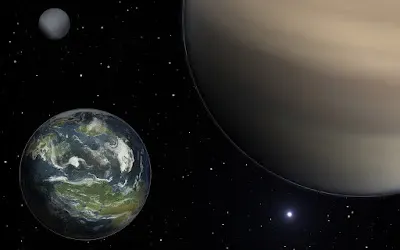Introduction:
Astrophysics, the branch of astronomy that examines the vast
expanse of the cosmos, has long captivated the human imagination. In recent
years, groundbreaking discoveries and technological advancements have propelled
astrophysics to unprecedented heights, allowing scientists to explore the
frontiers of the universe with unparalleled precision and depth. This article
embarks on a journey through the latest advancements in astrophysics, unveiling
the mysteries of the cosmos beyond the stars.
- Gravitational Waves: Ripples in Spacetime
The groundbreaking detection of gravitational waves in 2015
marked a revolutionary moment in astrophysics. Predicted by Albert Einstein a
century earlier, these ripples in spacetime are generated by cataclysmic events
such as the merging of black holes or neutron stars. LIGO (the Laser
Interferometer Gravitational-Wave Observatory) and Virgo collaborations have
since detected numerous gravitational wave events, opening a new window to
observe and understand the universe.
Gravitational wave astronomy provides a unique opportunity
to explore phenomena that were previously hidden from traditional telescopic
observations. It offers insights into the nature of extreme events, the
behavior of black holes, and the dynamics of cosmic collisions, fundamentally
altering our understanding of the fabric of spacetime.
- Exoplanet
Exploration: Beyond Our Solar System
The quest for exoplanets—planets orbiting stars beyond our
solar system—has evolved from a theoretical pursuit to a thriving field of
research. Advancements in telescope technology, such as the Kepler and TESS
missions, have enabled the discovery of thousands of exoplanets, ranging from
rocky super-Earths to gas giants.
Recent breakthroughs include the characterization of
potentially habitable exoplanets and the identification of exoplanetary
atmospheres. The James Webb Space Telescope, set to launch soon, promises to
revolutionize exoplanet research by studying their atmospheres in unprecedented
detail. These discoveries not only expand our understanding of planetary
formation but also fuel the search for extraterrestrial life.
- Dark
Matter and Dark Energy: Unveiling Cosmic Enigmas
The majority of the universe is composed of mysterious
substances known as dark matter and dark energy. While they do not emit,
absorb, or reflect light, their presence is inferred from their gravitational
effects on visible matter. Astrophysicists are actively engaged in unraveling
the nature of these enigmatic entities, which together constitute about 95% of
the cosmos.
Large-scale surveys, such as the Dark Energy Survey and the
upcoming Vera C. Rubin Observatory, aim to map the distribution of dark matter
and probe the accelerating expansion of the universe driven by dark energy. As
experiments on Earth, such as those conducted at the Large Hadron Collider,
search for dark matter particles, the quest to decipher the cosmic riddles of
dark matter and dark energy continues to be a central focus of astrophysical
research.
- Multimessenger
Astronomy: Coordinating Cosmic Messengers
The era of multimessenger astronomy has dawned, allowing
scientists to study celestial events using various forms of radiation and
particles. Combining information from electromagnetic waves, gravitational
waves, and high-energy particles enhances our comprehension of cosmic
phenomena.
Notable multimessenger observations include the coordination
of gravitational wave detections with gamma-ray bursts and the observation of
the collision of neutron stars, which produced both gravitational waves and
electromagnetic signals. These synergistic approaches offer a comprehensive understanding
of astrophysical events, providing insights into the intricate workings of the
universe.
- Black
Hole Astrophysics: Illuminating the Dark Giants
Black holes, once considered celestial mysteries, are now at
the forefront of astrophysical research. The Event Horizon Telescope (EHT)
collaboration made history by capturing the first image of a black hole in the
center of the galaxy M87. This groundbreaking achievement provided a visual
confirmation of the existence of black holes and offered a glimpse into the
intense gravitational forces at their cores.
Ongoing studies are delving into the behavior of black
holes, their interactions with surrounding matter, and their role in shaping
galactic structures. The exploration of black hole astrophysics not only tests
the boundaries of our understanding of gravity but also sheds light on the
fundamental nature of spacetime.
Conclusion:
The frontiers of astrophysics are expanding at an
unprecedented pace, driven by technological innovations and collaborative international
efforts. From the detection of gravitational waves to the exploration of
exoplanets, the quest to unveil the mysteries of the cosmos beyond the stars is
reshaping our understanding of the universe.
As we navigate through these frontiers, the interdisciplinary
nature of astrophysical research becomes increasingly evident. Astrophysicists,
astronomers, engineers, and physicists work collaboratively to push the
boundaries of human knowledge, using cutting-edge technologies and theoretical
frameworks to explore the farthest reaches of the cosmos.
The advancements highlighted in this article represent just
a glimpse into the vast realm of astrophysics. As technology continues to
evolve and our understanding deepens, the mysteries of the universe beckon us
to embark on an ongoing journey of exploration and discovery. Beyond the stars,
the cosmos unfolds in all its complexity, inviting us to question, learn, and
marvel at the wonders that continue to shape our understanding of the cosmos.





